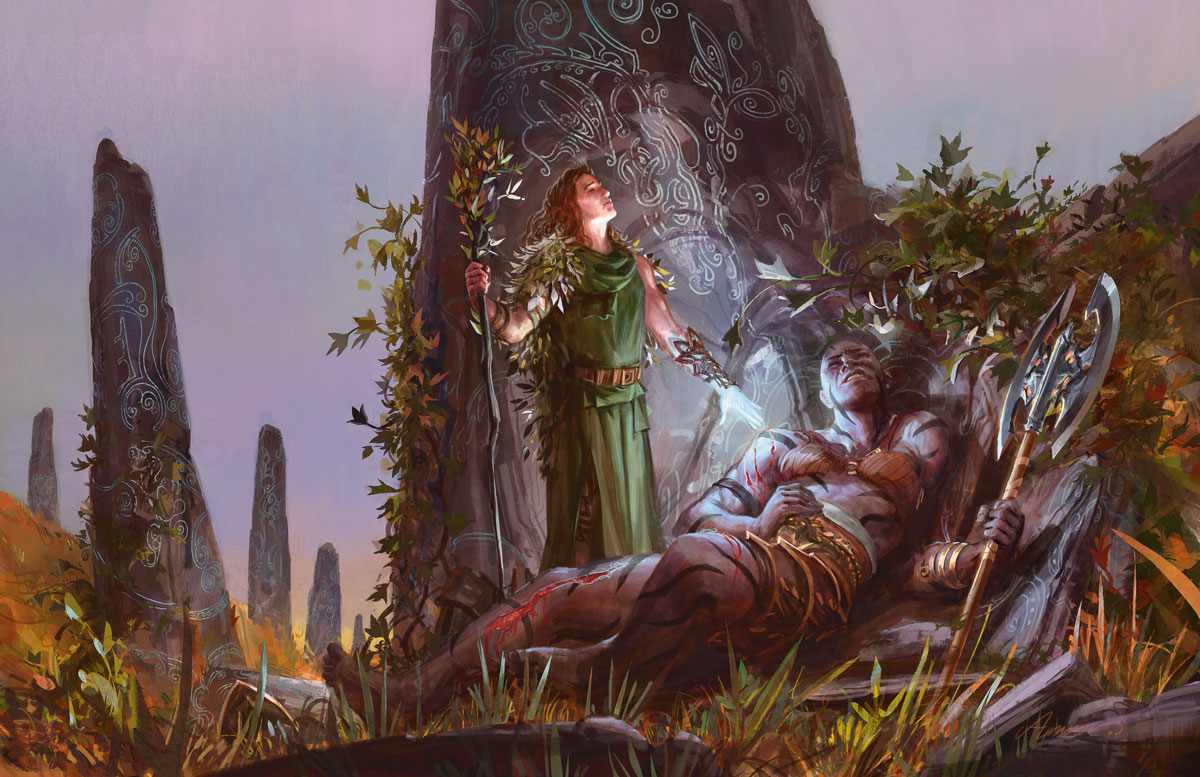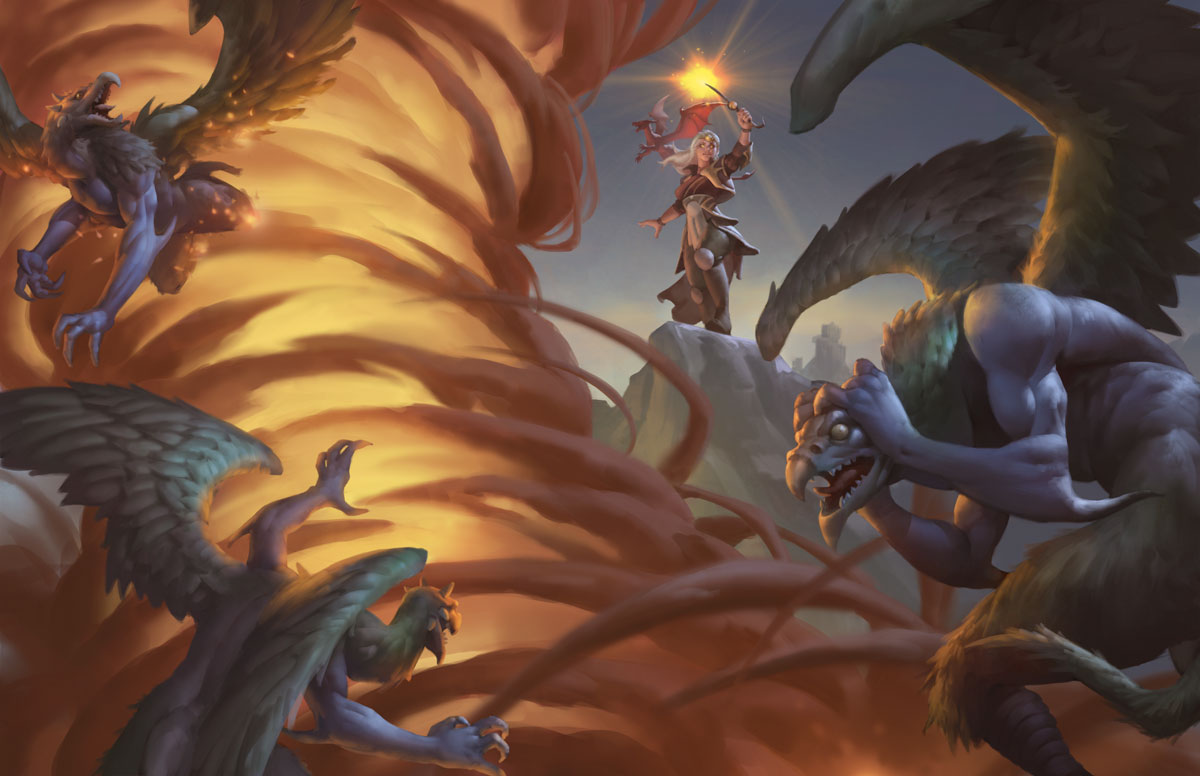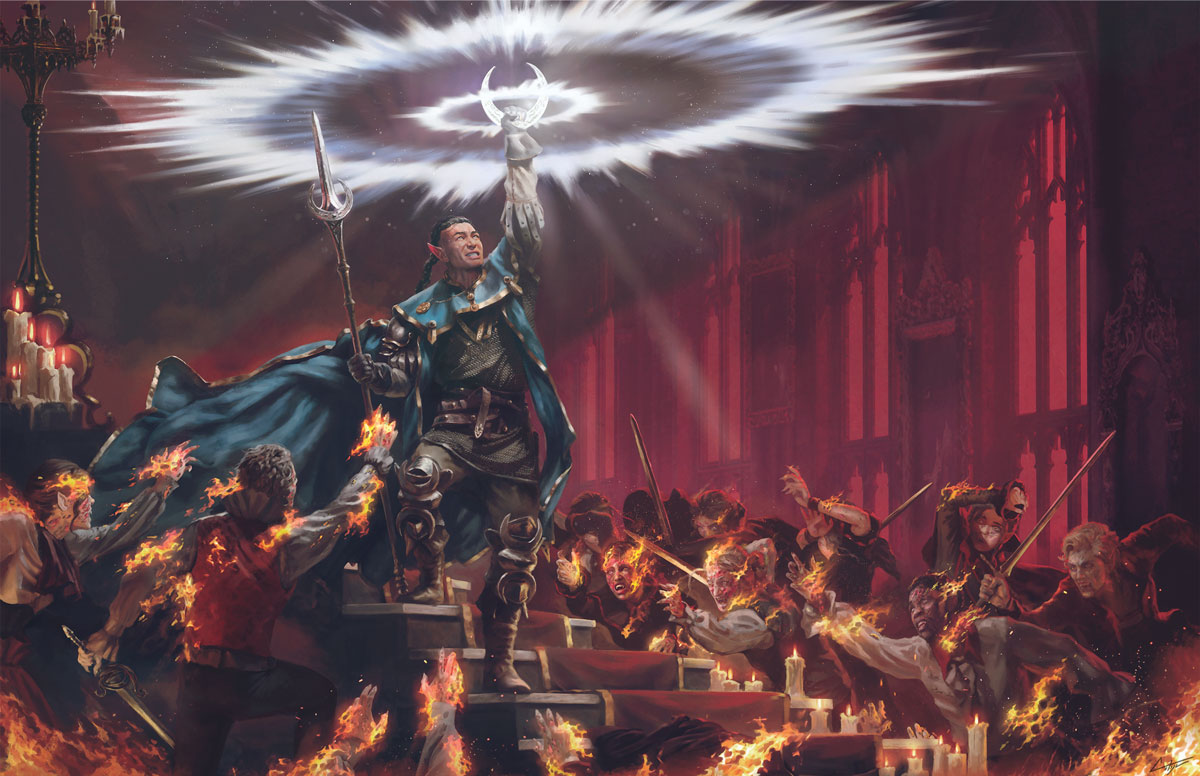Magic is one of the main elements that make Dungeons & Dragons so cool. Whether you’re pulling the Weave, strumming along to the Words of Creation, or drawing forth the divine power of your chosen deity (or patron!), using spells can give you the ultimate power fantasy: The ability to literally reshape the world around you. That’s why the 2024 Player’s Handbook is bringing you over a hundred pages of spells. You’ll find boosts to classic favorites, popular spells from sourcebooks being ported to the core rules, and even some brand-new spells!
In this article, we’ll discuss some of the overarching changes you’ll see with spells and even show you some of the new spells introduced in the 2024 Player’s Handbook.
- Many Favorite Spells Have Been Boosted
- It’s Easier to Find and Use Your Favorite Spells
- New Spells for the Core Rules
- Emanation Area of Effect
The 2024 Player’s Handbook is Now Available!
Buy the 2024 Player’s Handbook today and dive into revised rules, enhanced character options, and exciting gameplay innovations.
Get your copy on the D&D Beyond marketplace and seamlessly integrate your new content with D&D Beyond's library of digital tools built to make D&D easier, so you can focus on the fun!
Many Favorite Spells Have Been Boosted

One of the first things that long-term D&D players will notice when perusing the almost four hundred spells in the 2024 Player’s Handbook is that many of your favorite spells have been buffed up.
Your healing spells will keep you and your allies on your feet longer to reflect the cost of your action or Bonus Action and your spell slot in order to use them. For example, Cure Wounds now heals a base of 2d8 + your spellcasting modifier, and Healing Word similarly has a base of 2d4 + your modifier as a level 1 spell. And it’s not just dice increases. Many spells receive a new element of functionality. Prayer of Healing, which takes 10 minutes to cast, now grants the benefits of a Short Rest to up to five creatures in addition to restoring 2d8 Hit Points.
Damage-dealing spells have seen several boosts too. Cloud of Daggers used to have some diminishing returns on later rounds if enemies started to avoid your cube of swirling stabs. But that’s a thing of the past, because now you can use a Magic action on your later turns to move the cloud up to 30 feet. Similarly, Chromatic Orb has been updated with the potential to strike an additional enemy, really embracing the dodgeball vibe or chucking a magically infused sphere at your enemies.
A number of spells that saw little use from the 2014 Player’s Handbook version also saw some tweaks to make them more functional and enticing for you to add to your repertoire. Blade Ward, for example, was a fairly underused cantrip because it cost an action, only lasted a turn, and only granted resistance to Bludgeoning, Piercing, and Slashing damage for that one turn. Now, while it still takes a Magic action, this cantrip lasts for a full minute, with Concentration, and forces all enemies attacking you to subtract 1d4 from their attack roll for the duration.
These are just a few of the changes to some known spells, so be sure to look for your favorite spells in the 2024 Player’s Handbook to see what changes may be in store for you!
It’s Easier to Find and Use Your Favorite Spells

Speaking of looking up your favorite spells, the 2024 Player’s Handbook makes the process of finding, preparing, and using your spells as a player easier.
Now, you no longer need to flip to the back of the book to see what spells are available for your class. Each class has its designated spells listed in the class description for the class itself in the Character Classes chapter. So if you’re building a Cleric, the list of Cleric spells is right there in the same section as your class features and domain subclasses.
One of the big missions in revisiting spells was to really listen to and address questions and confusions players have had around various spells in the decade since the 2014 Player’s Handbook was first published. We tightened up the wording in some spell descriptions to make them clearer and more succinct, without changing the actual mechanics of the spells. We provided more artwork of the spells in use to give you more inspiration for imagining how the spell looks when you cast it. The Ritual tag has now been moved to the casting time to make it easier to find since it impacts the casting time of a spell.
As an example of changes to spells, the conjuring family of spells, such as Conjure Fey and Conjure Celestial, have been updated to officially reflect popular modifications that were playtested in Unearthed Arcana. The new versions of the spells now give you all the information you need when casting them in the spell descriptions themselves; for example, Conjure Fey specifies that the conjured spirit can make a melee spell attack against a creature within 5 feet, and on a hit, the target takes Psychic damage and has the Frightened condition.
This saves you from cracking open the Monster Manual to track your conjured creature’s information and makes them operate more similar to the Spirit Guardians or Spiritual Weapon spells.
New Spells for the Core Rules

The 2024 Player’s Handbook introduces some brand-new spells to the D&D spellbook. Some, like the Starry Wisp cantrip, were included in the Unearthed Arcana playtests, but some weren’t and will be making their debuts in the 2024 spell list.
Some of the brand-new spells include ties to the known spellcasters within the D&D multiverse. Our old pal Tasha has a brand new spell, Tasha’s Bubbling Cauldron, which creates a magical cauldron for 10 minutes that you and your allies can reach into and grab vials of a Common or an Uncommon potion of your choice. Jallarzi, a Celestial Patron Warlock with the distinction of being a non-Wizard member of the Circle of Eight, has a powerful namesake spell, Jallarzi’s Storm of Radiance. This spell creates a raging 40-foot cylinder storm that deals Radiant and Thunder damage. It also gives creatures within it the Blinded and Deafened condition and makes them unable to cast spells with a Verbal component.
Popular spells from the expanded sourcebooks have also now become part of the core spell list. Some, like Toll the Dead, introduced in Xanathar’s Guide to Everything, have gotten so ubiquitous that many don’t realize they weren’t initially part of the 2014 Player’s Handbook.
Emanation Area of Effect

Emanation is a new area of effect, joining known types like Cone, Line, or Sphere. An Emanation spell extends in a straight line in all directions from a creature or object, and moves with them if the spell duration is longer than Instantaneous. Emanation differs from a Sphere in that its origin is not considered part of the area of effect unless the Emanation’s creator decides otherwise (whereas a Sphere’s origin is always included in the area of effect). Known spells such as Thunderclap and Spirit Guardians are now classified as Emanation for their areas of effect.
This Spells Fun
The 2024 Player’s Handbook is now available on the D&D Beyond marketplace, which means it's time to set out on new adventures with fresh or familiar characters!
With almost four hundred spells spread across over a hundred pages, we’ve clearly only scratched the surface of the exciting changes coming to your spellcasting with the 2024 Player’s Handbook. Be sure to look through the complete spell list for your preferred spellcaster to see what changes are in store for your favorite spells, and what new spells are ready for you to play with.
We’re delighted to share with you the changes to fifth edition D&D that appear in the 2024 Player’s Handbook. Make sure to keep an eye out on D&D Beyond for more useful guides on using the wealth of new options, rules, and mechanics found in the 2024 Player's Handbook!

Riley Silverman (@rileyjsilverman) is a contributing writer to D&D Beyond, Nerdist, and SYFY Wire. She DMs the Theros-set Dice Ex Machina for the Saving Throw Show, and has been a player on the Wizards of the Coast-sponsored The Broken Pact. Riley also played as Braga in the official tabletop adaptation of the Rat Queens comic for HyperRPG, and currently plays as The Doctor on the Doctor Who RPG podcast The Game of Rassilon. She currently lives in Los Angeles.
This article was updated on August 13, 2024, to issue corrections or expand coverage for the following features:
- It’s Easier to Find and Use Your Favorite Spells: Added Conjure Fey as an example of how the new spell listing works.
- New Spells for the Core Rules: Remove plurality in the Tasha’s Bubbling Cauldron sentence to avoid confusion.
- Emanation Area of Effect: Clarified that the Emanantion’s creator can choose to include the origin in the area of effect.








-
View User Profile
-
Send Message
Posted Jul 3, 2024Is anyone else sad that we’re not getting artificer in 2024 PHB?
-
View User Profile
-
Send Message
Posted Jul 3, 2024Does Jallarzi’s Storm of Radiance seem really op to anyone else?
-
View User Profile
-
Send Message
Posted Jul 3, 2024So what dose is magic action mean ? Is it action that spererate from Action and bonus action or when you cast spell with your action you are using your magic action and action at the same time ??
-
View User Profile
-
Send Message
Posted Jul 3, 2024Same, this is probably one of the coolest pieces of art I've seen yet!
Plus, I'm a major Selune fanboy. She's my favorite goddess by far!
Moonmaiden bless you
-
View User Profile
-
Send Message
Posted Jul 3, 2024NOT liking the new conjure spells so those wont be used...or at least my players can use the older versions if they want. Just like any spell they nerfed in the ground. I refuse to accept the massive nerf bat they took an already nerfed game.
-
View User Profile
-
Send Message
Posted Jul 3, 2024Those spells lists simply made the game even more bland. The point of having different spell casting classes is to have different spell lists...otherwise make one, and call it done.
-
View User Profile
-
Send Message
Posted Jul 3, 2024I presume it's just a different name for the current "Cast a spell" action which didn't really fit with Attack action, Dash action, Disengage action, etc.
-
View User Profile
-
Send Message
Posted Jul 3, 2024If it follows the UA then it's a blanket term for any act that produces magical effects. Stuff like casting spells, using magic items, or special features like Channel Divinity.
-
View User Profile
-
Send Message
Posted Jul 3, 2024I have no issue understanding why she did it, what I'm saying is it was bad DMing.
That isn't a good justification to change how a spell works on a player in the middle of combat. As a DM I have plenty of tools in my tool box and tricks I can use to give reason why an npc can die, or not, or choose to leave or whatever. To change a spell like that on a player in the middle of combat isn't a good move. It breaks expectation of the rules in regards to how the spell works. If I did that to one of my players, they would feel cheated and would lose trust in my ability to be a fair and responsible DM.
If she were to do something that breaks the rules, and needed Cyrus to die, then I can think of many other ways other than literally just breaking a spell in front of a people in a very poor way. One is having an enemy roll a critical hit with max damage, having more enemies come in from another location, if Aabria is role playing Cyrus have him self sacrifice to save his brother, or make a poor choice in combat that gets him killed.
To look at a player cast a spell that works one way, and then to say... nah it works this way now because I want or need it to... is stepping over the line on that player and the social contract of the game. I'm a fan of critical role btw, just feel behind on campaign three. I don't hate Aabria or anything either. I just think she made a very bad call and choice as a DM. Just like many other fans of the show did. Not looking to start some long or big argument. My og reply was to a comment another had on how the new chrom orb might be related to the show.
-
View User Profile
-
Send Message
Posted Jul 3, 2024Level 6 Tashas Cauldron = Average of 5x (4d4 + 4) = 70 HP healing = Level 6 Heal Spell
-
View User Profile
-
Send Message
Posted Jul 3, 2024Did they fix the most useless of cantrips, Friends?
-
View User Profile
-
Send Message
Posted Jul 3, 2024Do you mean the cantrip "enemies"? At least in the playtest its now "friends" and is fixed.
-
View User Profile
-
Send Message
Posted Jul 3, 2024Any news on spell nerfs? I was hoping for more crowd control spells to become more akin to flesh to stone in progression. Would fix a lot of the save or suck spells
-
View User Profile
-
Send Message
Posted Jul 3, 2024Love the new Blade Ward. As a DM, I'm really happy players have access to a cantrip that lasts a minute that will have me rolling an extra dice and doing addition with the d20 and subtraction with the d4 on every attack. Definite improvement to my quality of life, especially if I'm rolling digital dice by clicking on an attack in a monster stack block in Beyond, I'll now have to be calling up an additional digital roller of a d4 and have to mentally figure out the outcome.
-
View User Profile
-
Send Message
Posted Jul 3, 2024its not that much difficulty....
-
View User Profile
-
Send Message
Posted Jul 3, 2024You can just substract a static number instead like -2. About the average and makes life easier for the DM
-
View User Profile
-
Send Message
Posted Jul 4, 2024I was really hoping for the resistance on Blade Ward as well. Even though this version technically blocks more damage over time (anywhere from 1 to 5 turns, depending on your AC), having resistance feels really solid, and makes the math a lot easier.
-
View User Profile
-
Send Message
Posted Jul 4, 2024There's also the new dragon designs being showcased on Friday after Bard. So we had spells and crafting this week, Wednesday, Thursday, and Friday off because of likely holiday reasons (it's a lot like Canada Day where people might book a day or two off after the fact for a long weekend), and then next week we'll get Monk, Sorcerer, Cleric, Bard, and ending it off with dragon redesigns to cap it all off in that order.
So at the end of the day unless they do a sneak peek at Bastion stuff from the DMG it makes some amount of sense to save the last 4 classes and dragons for last. And also the fact that as we have seen, they don't do videos and articles on weekends. So that "4 days" you mentioned is more like 2 days, if even.
-
View User Profile
-
Send Message
Posted Jul 4, 2024They likely made it a full action again because it counteracts with Earth Genasi's bonus action variant. So they can't make it a reaction because of the aforementioned issue and same with bonus action, as that would devalue the spell for them. Much like how playing a goblin rogue has anti-synergy because you have a bad 2nd level because you already get 2/3rds of it innately. It all goes against that part of forward compatibility so at the end of the day the only place it could even go is action.
-
View User Profile
-
Send Message
Posted Jul 4, 2024Any changes to Concentration? I mean, why is a 20th level wizard just as good as a 1st level wizard at Concentration (feats/ASI aside). That's always been ridiculous to me.